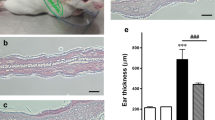Abstract
Recently, we have reported that the pathophysiological features of dermatitis induced by the repeated application with Dermatophagoides farinae (Df) extract ointment in NC/Nga mice were similar to those observed in the patients with atopic dermatitis. In the present study, we first examined whether the application of Df in other mouse strains could induce dermatitis. The repeated application of Df body (Dfb) ointment to the barrier-disrupted back of ICR, C57BL/6, and Balb/c mice did not cause any apparent skin lesions, although transient increase in serum immunoglobulin E (IgE) levels during antigen application was observed. On the other hand, in NC/Nga mice, dermatitis scores and serum IgE levels increased remarkably, and then these changes sustained for at least 10 days after stopping of antigen elicitation. Using NC/Nga mice, we investigated the contribution of scratching behavior to the development and maintenance of Dfb-induced dermatitis. In correlation with the increase in scratching behavior, erythema, hemorrhage, edema, scarring, erosion and excoriation were observed. Cutting off the hind toenails of mice exhibiting chronic skin lesions dramatically alleviated the dermatitis. From these findings, the onset of skin lesions and its chronically sustained course in Dfb-induced dermatitis in NC/Nga mice were closely associated with increased scratching behavior.







Similar content being viewed by others
References
Amano H, Negishi I, Akiyama H, Ishikawa O (2008) Psychological stress can trigger atopic dermatitis in NC/Nga mice: an inhibitory effect of corticotropin-releasing factor. Neuropsychopharmacology 33:566–573
Berth-Jones J, Graham-Brown RA (1989) Failure of terfenadine in relieving the pruritus of atopic dermatitis. Br J Dermatol 121:635–637
Hanifin JM (2002) Epidemiology of atopic dermatitis. Immunol Allergy Clin NA 22:1–24
Hashimoto Y, Arai I, Nakanishi Y, Sakurai T, Nakamura A, Nakaike S (2004) Scratching of their skin by NC/Nga mice leads to development of dermatitis. Life Sci 76:783–794
Herman SM, Vender RB (2003) Antihistamines in the treatment of dermatitis. J Cutan Med Surg 7:467–473
Iijima OT, Takeda H, Komatsu Y, Matsumiya T, Takahashi H (2000) Atopic dermatitis in NC/Jic mice associated with Myobia musculi infestation. Comp Med 50:225–228
Klein PA, Clark RA (1999) An evidence-based review of the efficacy of antihistamines in relieving pruritus in atopic dermatitis. Arch Dermatol 135:1522–1525
Koblenzer CS (1999) Itching and the atopic skin. J Allergy Clin Immunol 104:S109–S113
Leung DY, Bieber T (2003) Atopic dermatitis. Lancet 361:151–160
Matsuda H, Watanabe N, Geba GP, Sperl J, Tsudzuki M, Hiroi J, Matsumoto M, Ushio H, Saito S, Askenase PW, Ra C (1996) Development of atopic dermatitis-like skin lesion with hyperproduction in NC/Nga mice. Int Immunol 9:461–466
Morimoto K, Nabeshima Y, Mochizuki M, Oomizu S, Yamamoto S, Hide M (2006) The extract of syngeneic keratinocytes enhances IgE production from BALB/c mouse splenic lymphocytes in vitro. Arch Dermatol Res 297:358–366
Morita E, Kaneko S, Hiragun T, Shindo H, Tanaka T, Furukawa T, Nobukiyo A, Yamamoto S (1999) Fur mites induce dermatitis associated with IgE hyperproduction in an inbred strain of mice, NC/Kuj. J Dermatol Sci 19:37–43
Ständer S, Steinhoff M (2002) Pathophysiology of pruritus in atopic dermatitis: an overview. Exp Dermatol 11:12–24
Sugiura H, Omoto M, Hirota Y, Danno K, Uehara M (1997) Density and fine structure of peripheral nerves in various skin lesions of atopic dermatitis. Arch Dermatol Res 289:125–131
Takahashi N, Arai I, Honma I, Hashimoto Y, Harada M, Futaki N, Sugimoto M, Nakaike S (2005) Scratching behavior in spontaneous- or allergic contact-induced dermatitis in NC/Nga mice. Exp Dermatol 14:830–837
Tobin D, Nabarro G, Baart de la Faille H, van Vloten WA, van der Putte SC, Schuurman HJ (1992) Increased number of immunoreactive nerve fibers in atopic dermatitis. J Allergy Clin Immunol 90:613–622
Yamamoto M, Haruna T, Yasui K, Takahashi H, Iduhara M, Takaki S, Deguchi M, Arimura A (2007) A novel atopic dermatitis model induced by topical application with dermatophagoides farinae extract in NC/Nga mice. Allergol Int 56:139–148
Yamamoto T, Kaneko S, Hide M, Mochizuki M, Morimoto K, Yoshimura M, Yamamoto S (2002) Increase in serum IgE levels following injection of syngeneic keratinocyte extracts in BALB/c mice. Arch Dermatol Res 294:117–123
Acknowledgments
We thank Dr. M. Torii and Dr. S. Matsushima of Developmental Research laboratory, Shionogi & Co., LTD for their advice in histological evaluation.
Author information
Authors and Affiliations
Corresponding author
Additional information
Mina Yamamoto and Takayo Haruna contributed equally to this work.
Rights and permissions
About this article
Cite this article
Yamamoto, M., Haruna, T., Ueda, C. et al. Contribution of itch-associated scratch behavior to the development of skin lesions in Dermatophagoides farinae-induced dermatitis model in NC/Nga mice. Arch Dermatol Res 301, 739–746 (2009). https://doi.org/10.1007/s00403-008-0912-8
Received:
Revised:
Accepted:
Published:
Issue Date:
DOI: https://doi.org/10.1007/s00403-008-0912-8




